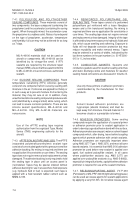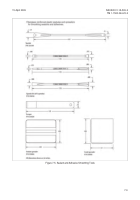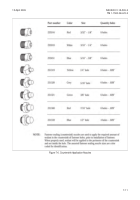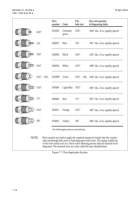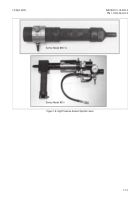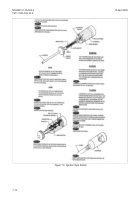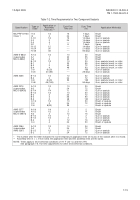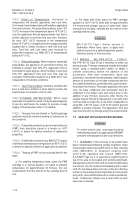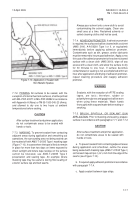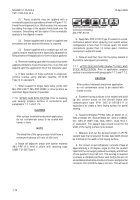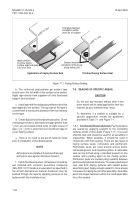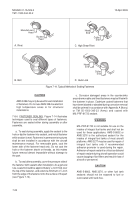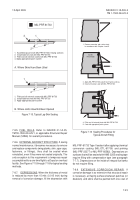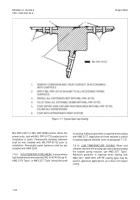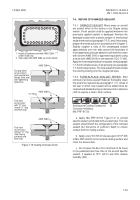TM-1-1500-344-23-2 - Page 132 of 240
7-16
NAVAIR 01-1A-509-2
TM 1-1500-344-23-2
15 April 2009
7-6.1.1. Effect of Temperature. Increases in
temperature will shorten application and cure time.
Conversely, lower temperatures will lengthen application
time and cure time. For polysulfide sealants, each 18
°
F
(10
°
C) increase in the temperature above 75
°
F (24
°
C),
cuts the application time by approximately half, with a
similar reduction in tack-free and cure time. Similarly,
for each 18
°
F (10
°
C) decrease in the temperature
below 75
°
F (24
°
C), the application time is approximately
doubled with a similar increase in tack-free and cure
time. Tack-free and cure times may increase for
polyioether sealants (e.g. AMS 3277) at temperatures
below 40
°
F (4
°
C).
7-6.1.2. Effect of Humidity. When sealants, especially
polysulfides, are applied in an environment where the
humidity is greater than 50% RH, application time is
shortened to some degree; when humidity is less than
50% RH, application time and cure time may be
extended. Polythioether sealants (e.g. AMS 3277) cure
independent of humidity conditions.
7-6.1.3. Tack-Free Condition. Sealant is considered to
be in a tack-free condition if, when lightly touched, the
sealant does not transfer onto the skin.
7-6.2. STORAGE INSTRUCTIONS. When large
quantities of sealant are used, it may be advantageous
to pre-mix and freeze the sealant to provide a ready
supply of mixed sealant when it is needed.
7-6.2.1. Two-part kits and Semkit or Techkit package
sealants should be stored according to instructions on
the container.
7-6.2.2. Polysulfide sealants in a pre-mixed and frozen
(PMF) form should be stored in a freezer at -40
°
F
(-40
°
C) or below for optimal retention of application
properties.
7-6.2.3. Polythioether sealants (e.g. AMS 3277) require
extremely low temperature refrigeration at -80
°
F (-62
°
C)
or below for optimal retention of application properties.
7-6.2.4. Thawing of PMF can be accomplished in two
ways.
a. For ambient temperature thaw, place the PMF
cartridge in a vertical position. Let stand at ambient
temperature for approximately 30 minutes. Dry any
condensation from the exterior of the cartridge prior to
use.
b. For water bath thaw, place the PMF cartridge
upright in a 120
°
F (49
°
C) water bath for approximately
4-6 minutes with plunger cup out of water bath. Upon
removal from the bath, carefully dry the exterior of the
cartridge before using.
WARNING
MIL-T-81772 Type I thinner solvent is
flammable. Never store, open, or apply near
ignition sources (e.g. lighted cigarettes, sparks,
electrical arcing, or heat sources).
7-6.3. MIXING
MIL-PRF-81733
TYPE III.
MIL-PRF-81733 Type III has a tendency to settle out
during storage. The base compound must be thoroughly
mixed, using a standard paint shaker, to obtain a
uniform consistency before the addition of the
accelerator. After both components, base and
accelerator, have been mixed separately, add the proper
amount of accelerator to the base compound and mix
the combined materials, preferably with a paint shaker,
for at least five minutes. For proper application time and
cure, the base compound and accelerator must be
combined in the proper ratio and mixed prior to the
addition of any thinners (solvents). After mixing, the
sealant may be thinned for spraying to a viscosity of 20
to 25 seconds in a Zahn No. 2 cup (refer to Appendix A)
using MIL-T-81772 Type I. A 20 to 30 volume percent
addition is usually required. The application time and
tack-free time will not change using this solvent blend.
7-7. SEALANT APPLICATION PROCEDURES
.
WARNING
To control solvent odor, used rags should be
immediately placed in an appropriate HAZMAT
container and disposed of per local directives.
7-7.1. CLEANING. If the surfaces to be sealed have
been contaminated following surface treatment, clean
the area with a clean cheesecloth (CCC-C-440), cleaning
cloth (AMS 3819), or nonwoven cleaning cloth
(CCC-C-46) saturated with solvent (AMS 3166,
A-A-59281 Type I or II, or equivalent), beginning at the
top of the area to be sealed and working downward.
Always pour solvent on the cloth to avoid contaminating
the solvent. Dry the surfaces immediately with a clean
cloth. Do not allow surface to air dry, as the oil or dirt may
remain on the surface and is impossible to remove with
a dry cloth. Use a stiff bristle brush to clean around bolts,
rivets, or fasteners. Always use a clean cloth as each
new area is cleaned.
Back to Top

